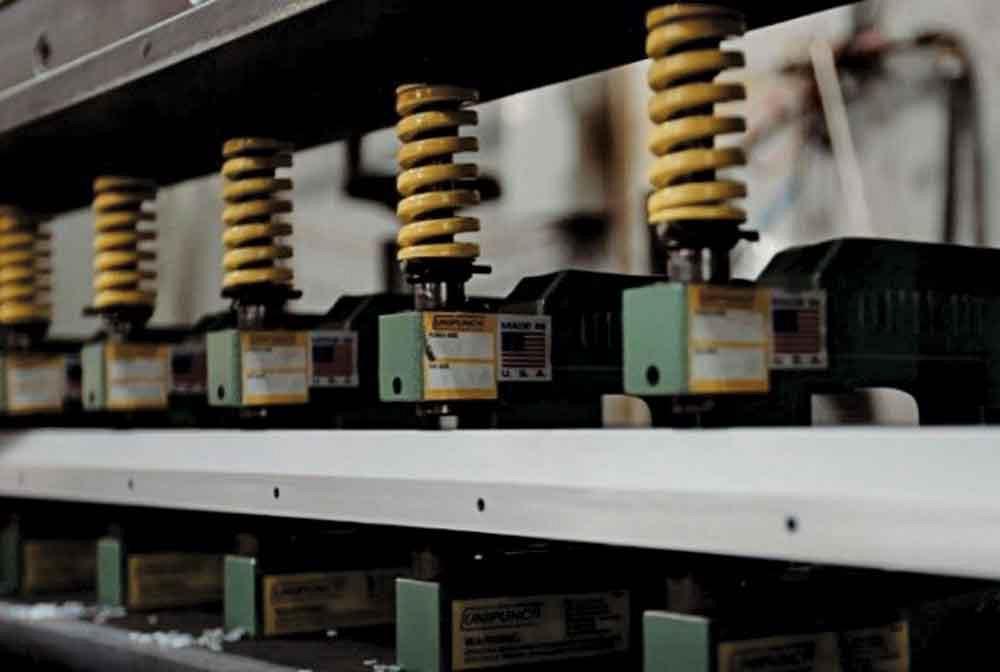- FMA
- The Fabricator
- FABTECH
- Canadian Metalworking
Categories
- Additive Manufacturing
- Aluminum Welding
- Arc Welding
- Assembly and Joining
- Automation and Robotics
- Bending and Forming
- Consumables
- Cutting and Weld Prep
- Electric Vehicles
- En Español
- Finishing
- Hydroforming
- Laser Cutting
- Laser Welding
- Machining
- Manufacturing Software
- Materials Handling
- Metals/Materials
- Oxyfuel Cutting
- Plasma Cutting
- Power Tools
- Punching and Other Holemaking
- Roll Forming
- Safety
- Sawing
- Shearing
- Shop Management
- Testing and Measuring
- Tube and Pipe Fabrication
- Tube and Pipe Production
- Waterjet Cutting
Industry Directory
Webcasts
Podcasts
FAB 40
Advertise
Subscribe
Account Login
Search
C-frame punching units make holes fast in building products supplier’s aluminum extruded trim
- January 13, 2020
- News Release
- Punching and Other Holemaking
Situation
Aluminum extrusions can be difficult to process because of their complex shapes. Manufacturers in industries such as windows, lighting, and shelving often are faced with the challenge of putting holes in extrusions to finish their products, but their options are few because of the extrusions’ irregularity. Drilling and machining are the most common methods used, but they can be costly and time-consuming.
Custom-designed die sets are an efficient option if there is enough volume to justify the expenditure. But lead times can be lengthy from die designers, and building the die in-house can require a lot of effort to get all the needed parts from various manufacturers. Die sets also can pose maintenance difficulties.
Tamlyn, a building products company based in Stafford, Texas, makes interior and exterior aluminum trim products. The company had a problem with some of its aluminum extrusions: Installers were using dry wall screws that were bending the trim. So Tamlyn wanted to make 20 holes in five different extrusion profiles, each measuring 10 to 12 ft. long.
Resolution
The building products company worked with Impress Inc., an industrial services and die design provider, to find a solution. They found that the volume of the five profiles would make a custom-made die cost-prohibitive. However, Impress had used a UniPunch system previously and recommended it as a good fit for the five parts.
A single setup can punch an entire row of holes in one stroke of the press, making it the fastest method for putting holes in extrusions. UniPunch pedestal dies are designed to fit inside of the profile of extrusions, where challenging holes need to be placed.
For Tamlyn, the system needed to be simple yet adaptable, as some extrusions require holes in two legs in a staggered pattern. To accomplish that, the part is first positioned against the left stop for one stroke of the press, then rotated 180 degrees and repositioned against the right stop for the second stroke of the press.
Costs were kept low with off-the-shelf UniPunch C-frame units. The only modifications were machined flats on the pedestal dies to accommodate the contours of all five parts. The result was a versatile punching system that delivered the speed and simplicity the customer needed.
UniPunch www.unipunch.com
subscribe now

The Fabricator is North America's leading magazine for the metal forming and fabricating industry. The magazine delivers the news, technical articles, and case histories that enable fabricators to do their jobs more efficiently. The Fabricator has served the industry since 1970.
start your free subscription- Stay connected from anywhere

Easily access valuable industry resources now with full access to the digital edition of The Fabricator.

Easily access valuable industry resources now with full access to the digital edition of The Welder.

Easily access valuable industry resources now with full access to the digital edition of The Tube and Pipe Journal.
- Podcasting
- Podcast:
- The Fabricator Podcast
- Published:
- 04/16/2024
- Running Time:
- 63:29
In this episode of The Fabricator Podcast, Caleb Chamberlain, co-founder and CEO of OSH Cut, discusses his company’s...
- Industry Events
16th Annual Safety Conference
- April 30 - May 1, 2024
- Elgin,
Pipe and Tube Conference
- May 21 - 22, 2024
- Omaha, NE
World-Class Roll Forming Workshop
- June 5 - 6, 2024
- Louisville, KY
Advanced Laser Application Workshop
- June 25 - 27, 2024
- Novi, MI































